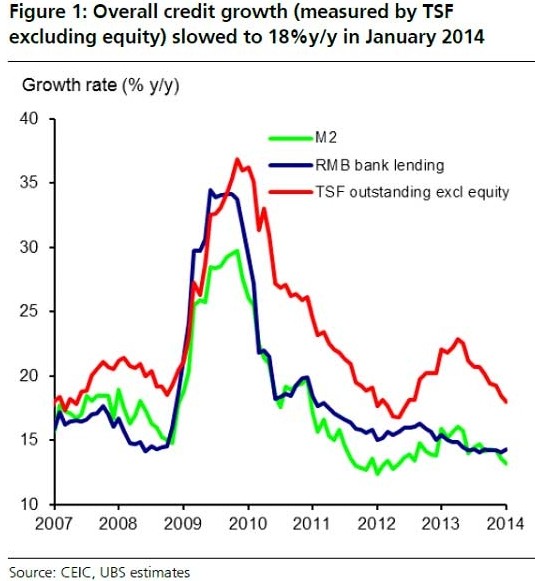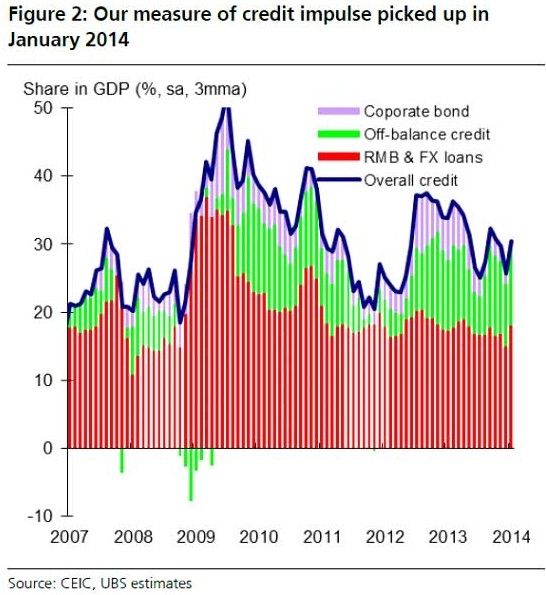


China's new bank lending and total social financing (TSF) exceeded market expectations in January. Net new RMB loans totaled 1.32 trillion yuan (UBSe 1.25 trillion, BBG average 1.1 trillion), while new TSF hit a record of RMB 2.58 trillion (UBSe and BBG average 1.9 trillion). While it is usual that new credit picks up in the beginning of each year as pent-up demand from the end of the previous year is satisfied and banks rush to front-load lending, the strength of this year's initial credit growth is still somewhat surprising. Clearly, market worries about excessive credit tightening due to rising interest rates or trust problems appear unwarranted for now.
New bank yuan lending saw the most growth compared with January 2013, while the rest of TSF was marginally weaker. Within the latter, off-balance sheet entrusted loans rose the most, by about 190 billion yuan; new issuance of bill acceptance was also high. In contrast, new trust loans weakened relative to last month and a year earlier, perhaps partly due to weakening investor confidence attributed to recent reports on troubled trust products. New corporate bond issuance also softened, possibly due to tighter liquidity conditions and higher interbank bond market rates.
Due to last year's high base, overall credit growth (as measured by TSF excluding equity fund raising) slowed marginally from 18.4 percent year-on-year in December to 18 percent year-on-year in January (Figure 1). However, from a flow perspective, new credit growth accelerated sequentially, as our credit impulse measure picked up from about 25 percent to 30 percent in January on a 3mma basis (Figure 2).
This latest set of data shows that despite recent bouts of liquidity tightening (initiated by the central bank) and increasing market concerns about the sustainability of certain shadow banking products such as trusts, credit growth remains rapid. This may have been because the central bank allowed credit conditions to ease somewhat in January, especially via bank lending, as the government still wants to protect investment and GDP growth and wants only moderately slower credit growth. In hindsight, the PBOC's tightening moves within the interbank market before the CNY were perhaps meant to prevent bank lending from growing at an even faster pace or from spiralling out of control, rather than to aggressively tighten as markets had feared at the time.
Yet, why has credit demand remained so strong? There may be a number of reasons: the economy remains highly dependent on investment and on credit; credit demand is usually strong in the beginning of the year due to pent-up demand from the previous year-end and a usual desire to secure lending before any potential tightening takes place; not all TSF created may be new credit feeding directly through to the real economy (in other words, some could be classified as "double counting") and simply mirrors the activity of some corporate and non-bank institutions' increased role in financial intermediation. It is not impossible that corporate demand for credit may be recovering due to a better economic outlook, but the deceleration of corporate demand deposit (reflected in M1) does not support this. Of course, one should not over-interpret the sudden drop in January's M1 growth, which may have been caused by the different timing of Chinese New Year (CNY) this year, which fell on the last day of the month.
Why have higher rates and tighter interbank liquidity not led to a weakening of credit growth? As we have written before, despite their recent increase, interest rates in China remain well below market-clearing levels, so are not yet at a high enough level to constrain aggregate credit growth. Moreover, important segments of the economy (including local government financial vehicles and some state-owned enterprises) continue to operate under soft budget constraints and thus are not very sensitive to interest rates changes. These factors enable credit demand and credit growth to stay robust, despite rising interest rates. Lastly, the development of multiple new credit channels and products is also an important contributing factor.
For 2014 as a whole, we maintain our forecast that credit growth (measured by TSF excluding equity) will slow moderately to just below 16 percent, although it start off more robust for the first few months. We are less concerned about a sharp slowdown in credit growth due to aggressive tightening or the continued rise of interest rates, and more concerned about credit volatility triggered by renewed bouts of liquidity squeezes, a tightening of shadow credit regulations, or more importantly, any potential credit defaults in the shadow credit market that could lead to a temporary shrinkage of certain credit markets.
The author Wang Tao is Chief China Economist at UBS.
China‘s lending slows amid credit tapering
2014-01-16Liquidity still tight in interbank lending market
2013-12-24Copyright ©1999-2018
Chinanews.com. All rights reserved.
Reproduction in whole or in part without permission is prohibited.